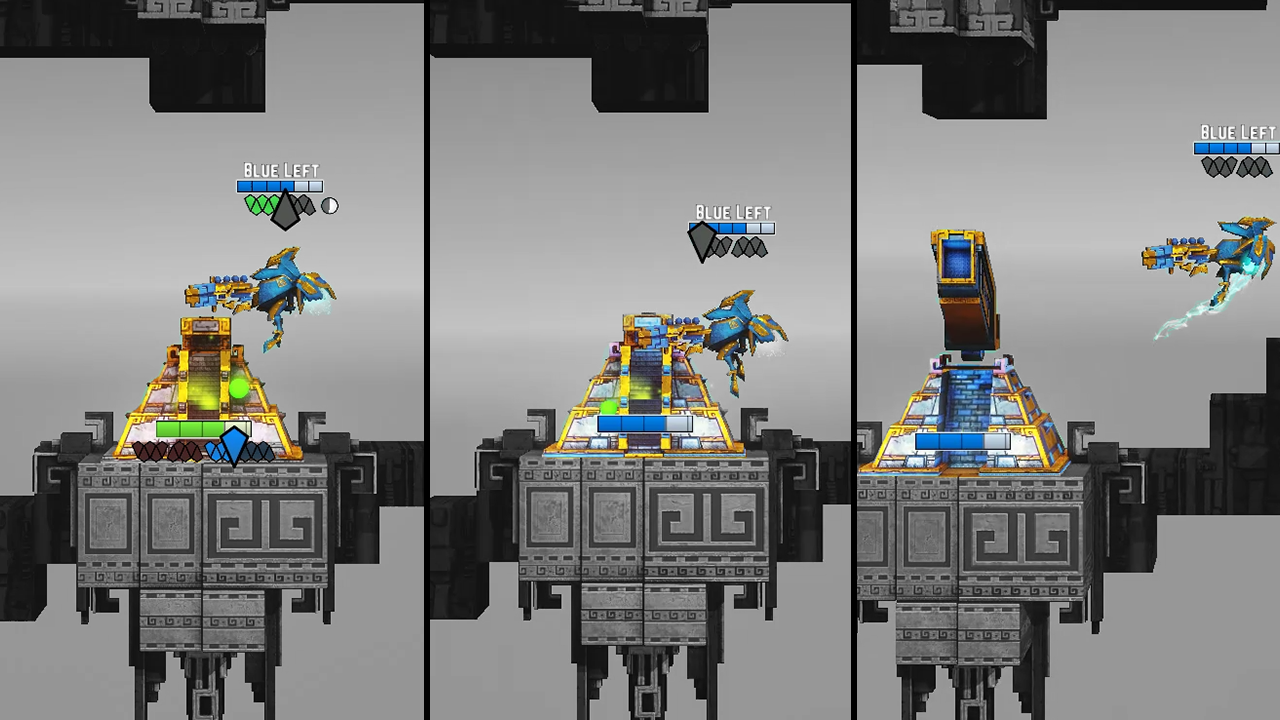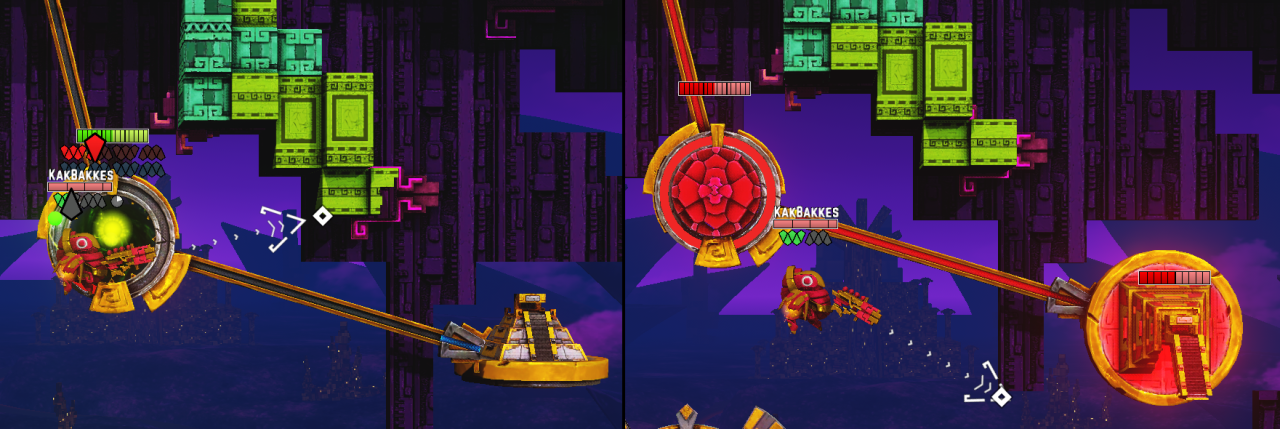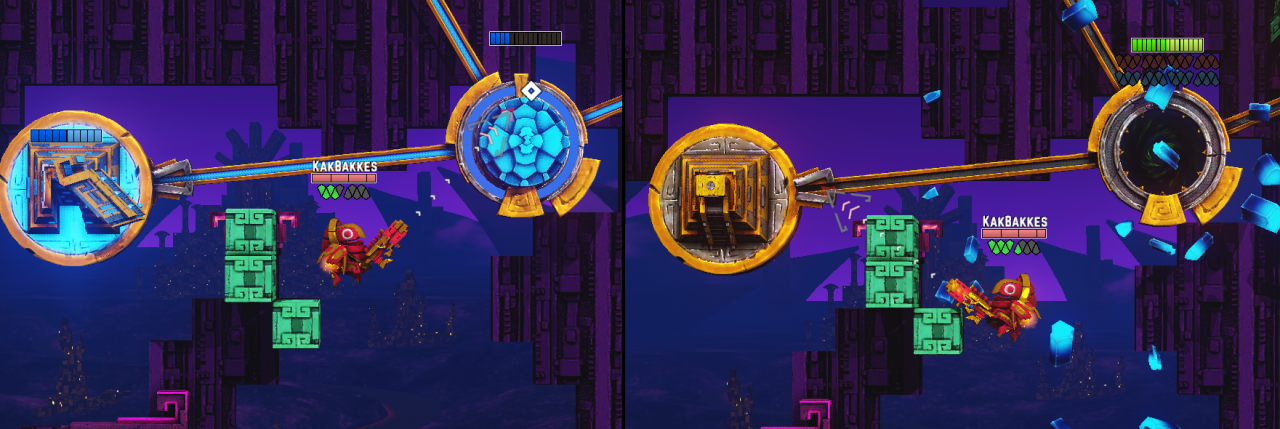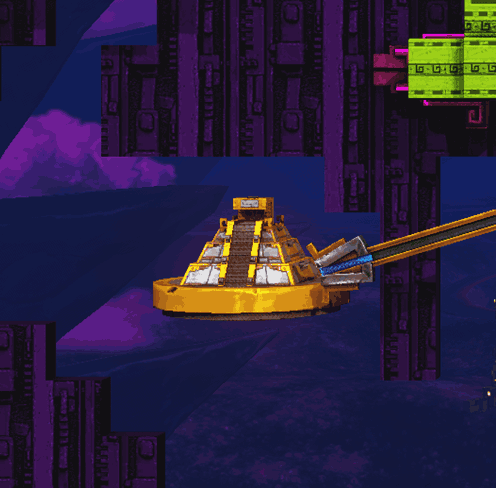As we continue working hard to make our stonepunk arena action game Antegods a reality, you can stay up to date on our development process with regular blog posts from our design, art and code departments.
This time, Game Designer Wytze will share the team’s efforts to fix one of the game’s biggest issues and add some strategic depth to the game in the form of Native Regions.
Region Control
A couple weeks back we started working on Region Control, an important feature to accomplish our overarching goal of making Antegods a more deeply strategic game.
For a long time we’ve had a very basic way for players to gain control over a level: by capturing Turrets. You would deliver Energy to a Turret to capture it, which would then activate and fire at your enemies. Once captured a Turret irreversibly belongs to that team, and disabling them meant permanently destroying them.

There were two big issues with this:
- There’s no flexibility in the mechanic; no way of regaining control over the level. This turned into very stale gameplay.
- It had to be difficult to destroy Turrets, because otherwise there was no incentive for players to capture them at all. This made destroying them a frustrating activity.
These issues led us to create a more elaborate mechanic for level manipulation: Region Control.
The basic mechanics
Every level will have a number of Native Regions. These Regions consist of a central Region Control Point and several Turrets.
The Regions are captured when a team delivers enough Energy to the Region Control Point, at which point the control point solidifies and all turrets activate.

Activated turrets can be disabled by destroying them (they’re a lot easier to destroy than previously). After a minute they reactivate for their controlling faction with full health.
A captured region can be neutralized by the other team by destroying the Region Control Point. After neutralizing a region, it can be captured again by either team.

Playtesting
I set up two goals the mechanic had to accomplish during playtests to stay in the game.
- Teams have to make strategic decisions to spend energy, time and effort in order to capture a region, which have a considerable impact on the course of the match.
- Players have interesting and decisive fights trying to capture and neutralize regions.
After implementing the experimental mechanic into a separate prototype we started playtesting. We went through a total of 5 playtest sessions, after each of which I analyzed the problems that popped up and thought up with solutions. Below are three of the major problems we encountered over the course of these playtests, and how we solved them.
Problem: too many Regions and Turrets
Problem: We initially had too many regions (9) and turrets (27). This had a number of detrimental effects on the game. First off, battles become more chaotic and crowded due to all the turrets involved. This makes battles more frustrating, as dying and killing feels more random and less satisfactory.
It means there are too many points to contest. Having 9 regions in the game means that there’s an additional 9 possible contest points that people can fight over. This will dilute the conflict, so players will be spending less time in interesting fights.
Solution: This problem was simple to solve: there’s now a maximum of 6 regions. Some regions only have two turrets instead of three. The reduced number of regions and turrets makes it easier and less frustrating to get around the level and reduces the chaos in battles.
It also reduces the number of contest points, leading to conflicts that are more fun between the teams.
Problem: Energy out of balance
Problem: Region Control was the first mechanic where Energy is ‘drained’ from a match. Theoretically an infinite amount of Energy can be dumped into Regions as long as they’re being neutralized and recaptured. Whereas the Turrets only costed 10 Energy to capture in previous versions we increased the Regions to cost 20 Energy. The differences are very noticeable, especially at the start of the game, where it takes a long time for the Titan to get powered up at all.
Solution: This was partly solved with the previous problem: having fewer regions means that there is less energy required to capture all regions, which led to powering up the Titan faster.
The second solution was to automatically capture the region nearest to the team’s starting position at the start of a match. This means teams don’t have to spend Energy and time to keep their Titan safe when in a new match, thus leading to the more interesting conflicts earlier.
Problem: combat ruined by collision
Problem: Collision on Region Control Points and Turrets caused issues multiple times. Initially the Region Control Point blocked both Totems and projectiles, which meant players would be avoiding conflict by constantly circling the structure. It was also frustrating for players when they’re shooting at opponents their shots are blocked by allied and neutral Turrets. The Region Control Point and Turrets are large obstacles, so this happened very frequently. Finally, the Turrets took away a lot of freedom of movement from the Titan. When piloting the Titan you usually had to take large detours to get past regions, which was very frustrating.
Solution: To completely change how the collision on Region Control Points and Turrets worked. Firstly Totems, Titans and projectiles all pass through neutral Turrets, as they’re now positioned in the background.

Once a Region Control Point or Turret is captured it blocks all Totems’ movement and enemy projectiles hit it, but friendly projectiles shoot through it.
Finally, if the Titan moves over an allied Turret it temporarily deactivates and moves into the background, giving the Titan a lot more freedom of movement.
End results
Allowing players to neutralize and then gain control over parts of the level makes the progression of a match more dynamic. Players have more freedom in choosing where they want to gain ground and place their Titan. During testing we’ve seen the level being captured nearly entirely by one team, only to then see the other team crawling back into the match by slowly recapturing Regions. Although the capturing team had gained a head start in powering their Titan, both teams still had a good chance of winning. With the previous mechanics the losing team would’ve had no real chance of winning the match after a disadvantage like that.
Additionally the end-game, when players control their Titan, has become more interesting, as long as players are careful with regards to Turrets. Because the Regions are a great safe haven for Titans, it allows teams to back up to a better position in the level. When you’re attacking you can neutralize and capture a region nearby your Titan, so you don’t have to retreat through half the level. Meanwhile defenders can back up to other regions they control, or find a new safe haven by capturing Regions on the other side of the level.
Overall we’ve seen a lot of back-and-forth in games, which is exactly the dynamic we were aiming for. The initial playtests were very rough with a large amount of gameplay issues, but we were able to solve these and improve the Region Control mechanic. This has really deepened the strategic options for players in Antegods. We’re very happy with the results and are very excited to put this mechanic into the hands of new players!
Follow our development!
To follow our development updates, please check us out on Tumblr, Twitter or Facebook. Or subscribe to our newsletter. Whatever is your taste in social media!
Antegods is supported by the Dutch Cultural Media Fund, Cultural Industries Fund NL and the MEDIA Programme of the European Union. 
